
The Grandmothers of Acoma
RV travel mornings often start with the comfort of simple routines. A cup or two of coffee and, because it's Sunday, an hour and a half with the tales, interviews and third cup of nostalgia with the gentle wake up of CBS Sunday Morning. Except today's view isn't of the Denver skyline, but an RV park adjacent to the Sky City Casino off of I-40 in western New Mexico.
Sky City. The name alone carries a sense of myth and mysticism and, for us, it offers a mystery and call for exploration. It's known by another name, the Acoma Pueblo (ack-o-ma) and in the ancient tribal language of Keresan, tribal members define Acoma as "the place that always was." An ancient Indian pueblo built atop an imposing mesa that has been inhabited for hundreds of years seems like a tale lifted from the Old Testament.
Being a Sunday morning, outside of tourist season, and at a location that takes a little effort to get to, there isn't much activity in the handsome visitors center as we pull back the heavy wood doors to enter. Our tour tickets are purchased with an included camera permit and then it's a few footsteps to the right to browse through a surprisingly elegant gift shop as a way to kill a half hour before the tour van arrives.
The shop is empty, but behind museum-style glass cases, the beautiful pottery that the Acoma tribe members are known for are brightly displayed. Of course, these modern pots, following ancient traditions, are all for sale ranging from $150 to $2,500 dollars. In the center of the room, a three-sided glass countertop displays more handicraft items. But, we're here to tour, not buy, and as our appreciative survey wanes, a native American woman, probably in her late 40's or early 50's, walks in, sits down in the chair behind the counter and cheerfully strikes up a conversation that within moments becomes an impromptu orientation of the Acoma tribe.
Her name is Gwen. She had grown up on the pueblo and, though she seems fairly young, talks about her daughters and granddaughters. This is one of our first revelations about tribal life that, in most of the Puebloan cultures: they're matrilineal. The women own and control property and, as Gwen says quite offhandedly, "the men govern." For an ancient culture, their rules are both practical and complex. Families are sorted by clans. You are not allowed to marry any relatives in your clan (a memo the Romanov's never got), a daughter's birth is more desired, and the youngest daughter will be the one to inherit the parent's property. The latter rule is eminently practical when considering long-term familial real-estate transference.
Like many artisans in the tribe, Gwen came slowly to pot making, encouraged in adulthood by her father, "My father used to tell me, talk to the pot. Tell it what you want it to be." Clearly, as Gwen sees it, every piece, whether it is used at home or taken away as a purchased souvenir, has a story and a destiny.
Acoma artists use two techniques to create their pots. The first, and most traditional, is to build up the pot using coils of clay and as the clay starts to set, use a scraping tool to smooth it. One grandmother, who we would meet later on, would tell us that her tool of choice is a coconut shell. The second pot forming technique is to use a mold. Shapes vary but follow some general geometric patterns which are painted on with highly contrasting natural colors. "Feel the inside of the pot," Gwen suggests. "That rougher feeling is that we grind up old pot shards that get remixed in the clay." Of course in a native society, not all that far removed from subsistence living, every discard is put to use. And while an unsentimentally practical form of recycling, I enjoyed the thought that the souls of many pots become one in a new one.
Our next grandmother, Geri, also looks fairly young. Geri will be our tour guide for the next ninety minutes and welcomes us as we step into the small shuttle bus that will take us to the top of the mesa and the pueblo. It's nearly a private tour as there is one other member, Karl, who is visiting from Germany and will provide us with a final surprise to the morning, but only after several others occur.
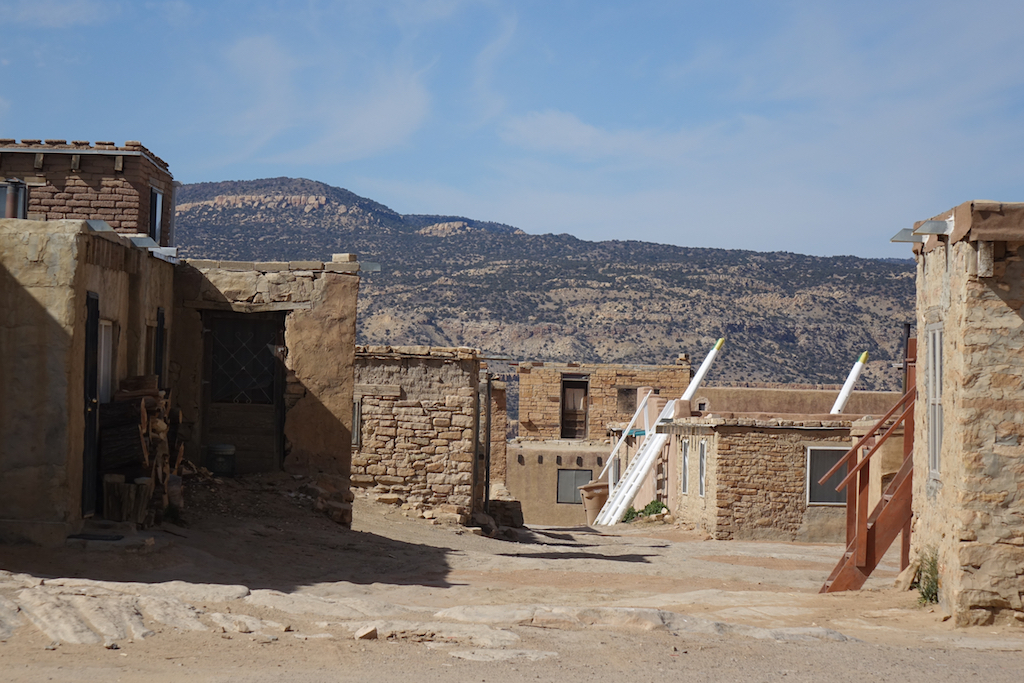
Within a few minutes, we are at the top of the mesa and standing between the homes of the Pueblo. Geri tells us that the homes are designed for open family living --in other words, there are few interior walls. There is no electricity to the mesa and heating and cooking is done with a variety of woods (pinon, pine, and cedar) and propane. Water must also be brought up and there is an occasional hum of a generator, but the 21st century has also brought a growing interest in solar. Today, many of the homes serve less as permanent residences than they do as the equivalent to a family cabin which is often used during festival and ceremonial days. To keep watch over the Pueblo there are five full-time caretakers who live and work on top of the mesa for a period of time that was loosely described as, "more than a year." Theirs is both a job and sacred obligation.
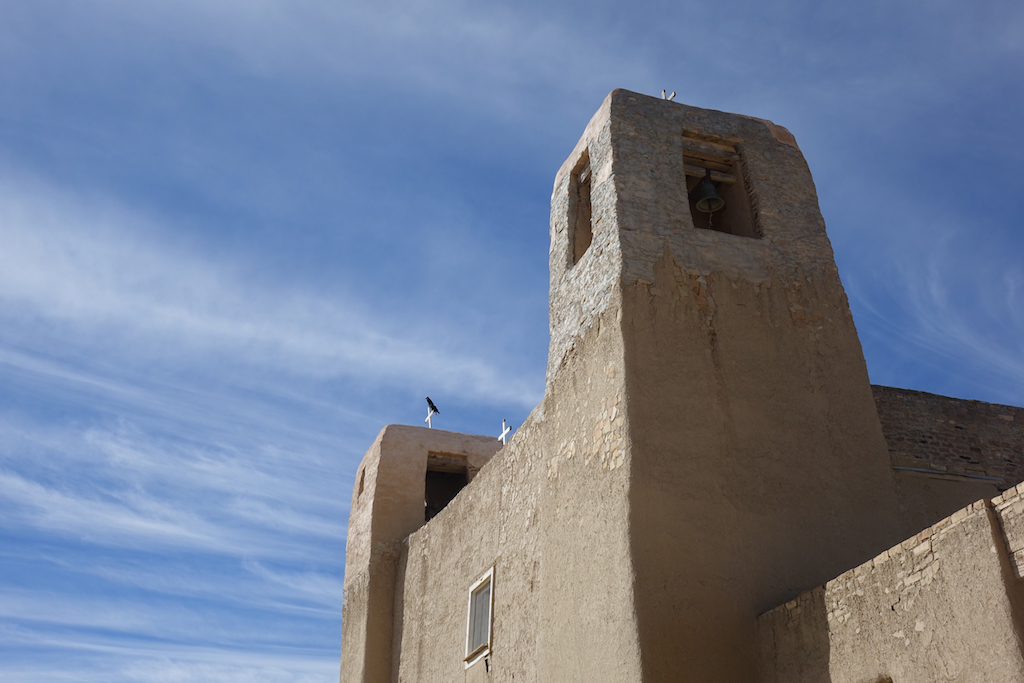
On the southern end of the mesa stands the adobe smooth walls of a typical mission church. Its construction dates back to the 1600's, though a new roof was redone (using authentic viga timbers) in 1974. Of all the southwest Catholic churches we've been in over the years, this is the first one we could ever recall with a dirt floor. The smooth walls are lightly tinted with beige and pink and surprisingly there are only a few rows of pews close to the altar as its religious importance has been usurped by a more modern church a few miles away in another valley on the tribal land. 19th-century lithographs hang on the walls mixed with an amalgam of 17th-century religious folk art.
Geri matter-of-factly explains the Catholic's brutal methods of conversion without any real sense of ancestral bitterness. I look up at the altar and my eyes follow the square paintings of the saints as she identifies them. For no reason, in particular, I turn around to look out the front doors. The outside view is framed with two dusty sandstone colored dogs, clearly well-fed and well-kept, and who have quickly become our playful entourage laying at the threshold of the square doorway while somehow knowing that their place is to remain outside. Beyond, the bright morning light radiates across the centuries-old cemetery with weathered white crosses casually askew on the topmost layer of centuries of bodies put to rest. Past the low adobe walls of the cemetery a wide valley falls below and a few miles to the east is a rim of distant mesas. It is a "New Mexican moment," of artistic muse floating across the breeze laced with a hint of burnt pinon, mixed by unfiltered sunlight and canopied with pure blue skies and wisps of white clouds. This is the moment that has inspired generations of artists from ancient natives adorning bowls with natural pigments to 21st-century artists positioning acrylic canvases beneath halogen lighting for a Santa Fe gallery opening. My hands itch to lift my camera to capture the scene, but the rules are sternly clear that no photography is allowed in the church or cemetery. And perhaps that's why I linger here a little longer to push this luminescent memory into a safe place where it can be fondly found again.
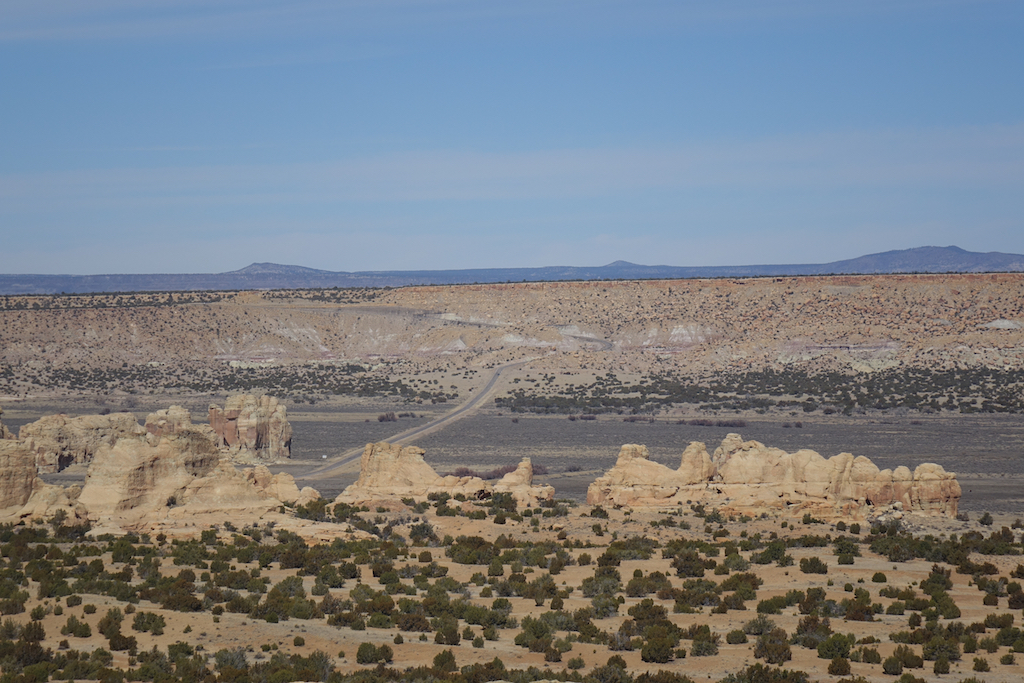
We're out of the church and the Sony is now back at eye level capturing angles, textures, and vistas. Our tour continues with a mixture of history, customs and, not unexpectedly, marketing. As we stroll through the pueblo our route has been carefully planned to take us by folding tables covered with fabric and bedecked with pots, jewelry, prints and other assorted knick knacks. Our first stop is "section 1" where we are met by a more elderly grandmother who steps outside to gently show us the stories and color symbolism of her pottery. The next is "section 2" where Daisy Lewis who in age, temperament, and sweetness exudes grandmotherly warmth. Beyond Daisy's settled grace the quality of her pottery work is far better than what I've seen. With her welcoming smile, soft voice and rich explanation of her work, I'm tempted to buy a piece, but stop short, extend my thanks and make a note that I may bring Terry back after the tour.
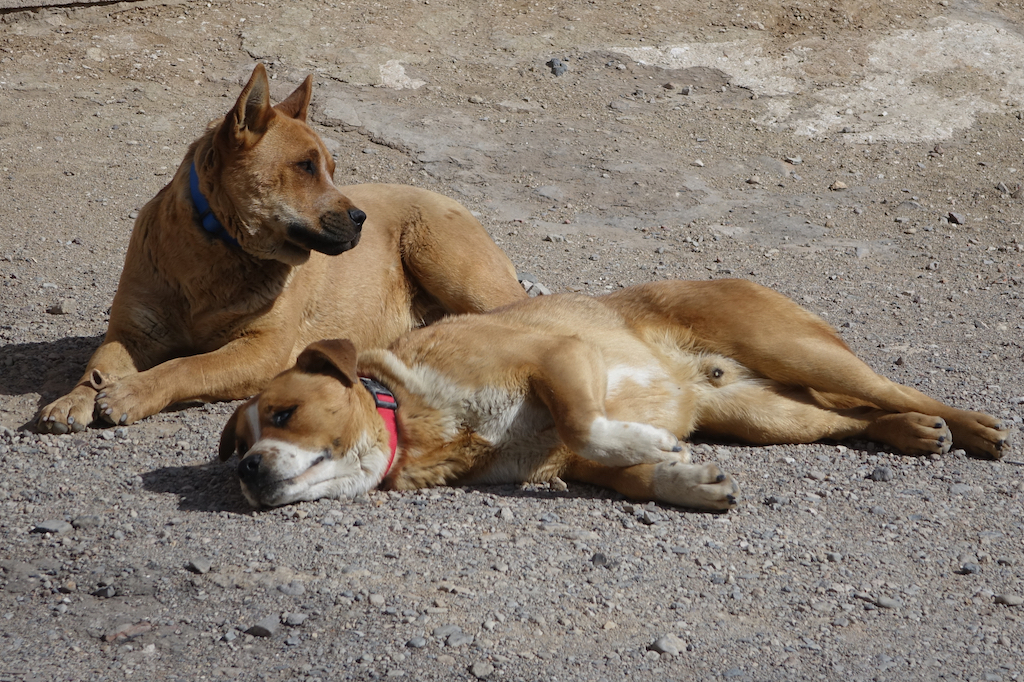
Not all of the local artists are grandmothers. As the two spirited pooches weave in and out of our legs Terry stops in front of a home where the entire family comes out to greet us. Dad works in bright acrylics painting which might best be described as native miniatures. I'm not sure what mom makes, but Terry hones in on a simply painted clay refrigerator magnet of a bird and, without any haggling, gives its artist, their five-year-old son, five dollars.
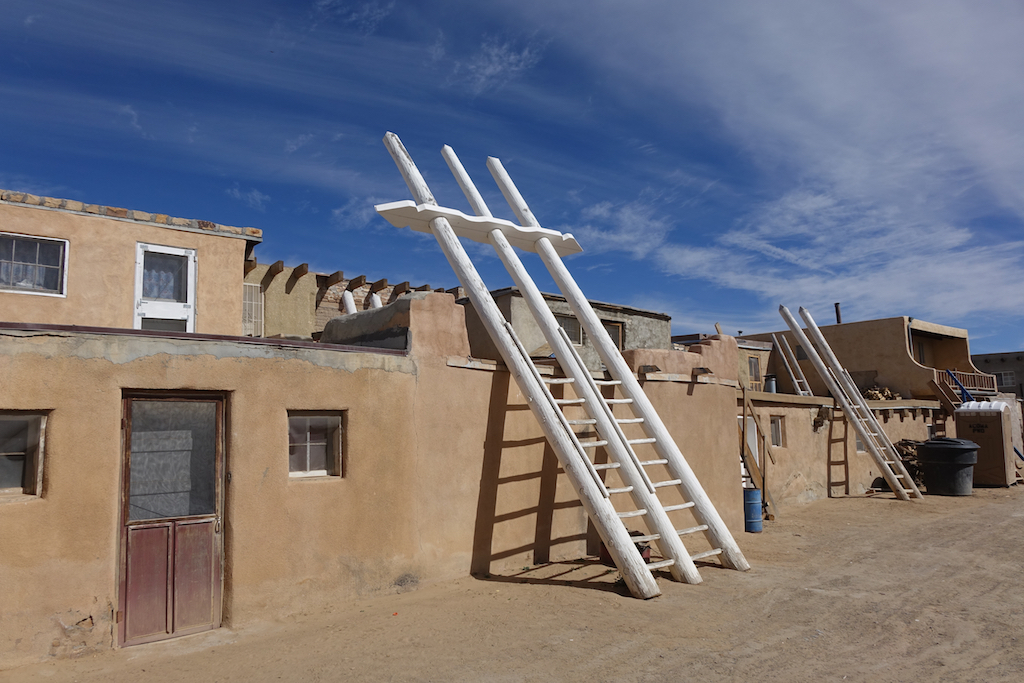
We stop at the edge of one of the mesa's sheer cliffs for a vista well worthy of a wide angle lens. As we walk, I start to ask Karl a few questions about where he's from. He tells me that he's from Heidelberg, Germany where he's a professor and that on Monday he'll be attending a conference at Sandia Labs in Albuquerque. I'm about to dig a little deeper as we walk down a dirt lane between pueblo buildings, but as if on cue -- another grandmother appears at a doorway with a tray of freshly baked fruit pie turnovers. I joke with Geri that "it's like she saw us coming" to which her answer with a smile is, "Yes she did." Two dollars and one cherry pie turnover later we continue our tour which has new become more a gallery walk than a history lesson.
I count another grandmother to the right of the lane with a less impressive display of trinkets, and then one on the left who explains that she traded chores with her five-year-old granddaughter who strung the simple bead necklaces while grandma did the dishes last night. Almost shockingly, in between grandmothers are a young man and woman standing between their car tailgate and tables of decorative jewelry. We chat for a few moments, politely ask about their work, say "thank you" and move on where yet another grandmother appears on the right with more turnover pies for sale. Real estate positioning is everything as our pie needs have already been met with the grandmother positioned "upstream" of her competitor. Nonetheless, Terry overhears Geri say quietly to the other baker, "I'll bring the next group by sooner."
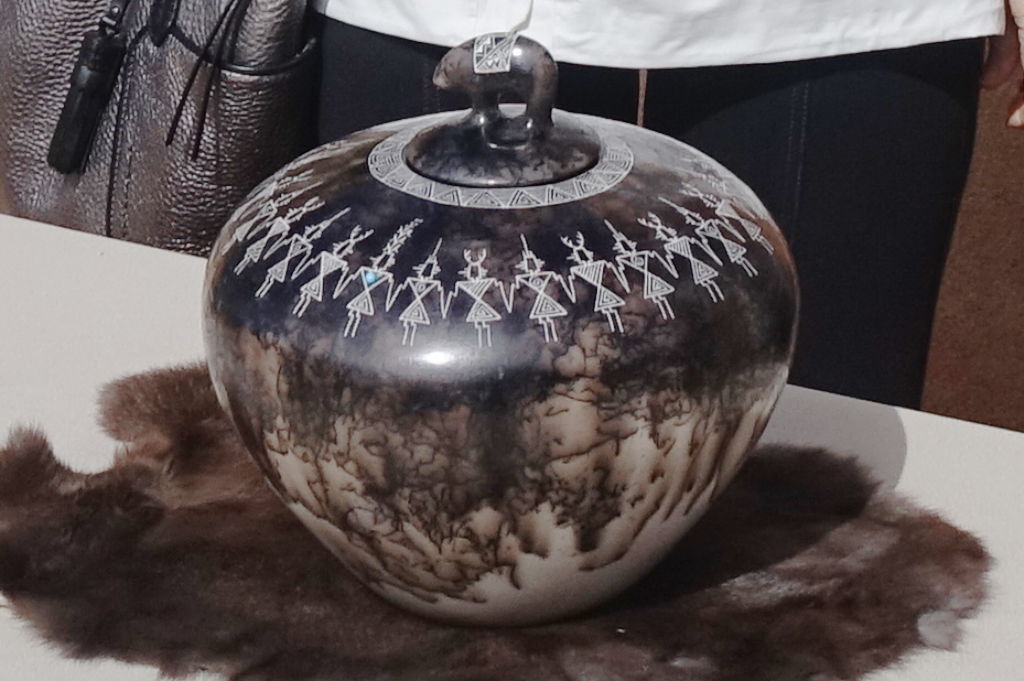
We are close to the end of the tour and I spot one more table, this time with a middle aged man behind it. Unlike many of the table displays we've seen, this one isn't overly cluttered with a confusing array of merchandise. The pottery is surprising -- contemporary. There are only nine pieces displayed and in the center, on a piece of fur, is a large seed pot with a carved bear lid. It has a smoky dripped glaze style, unlike anything I've ever seen before and is impressively elegant.
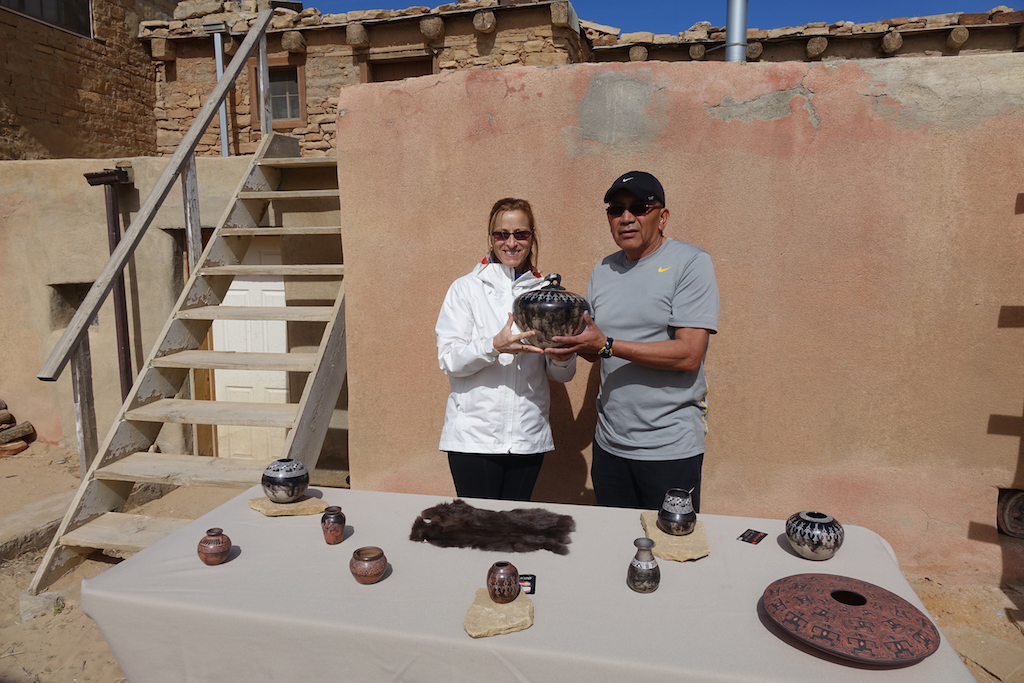
The man standing behind the table remains silent and simply smiles. There's no pitch. He patiently waits. With his swoosh branded hat and t-shirt I ask him if he's from the Nike clan. He laughs easily and answers, "no, from the Corn clan." His name is Irvin Louis and as I more carefully examine all his pots I ask him what the prices are. He points to each one and quietly announces its cost. When he gets to the large seed pot I feel myself tightening my lips when he says the price. If I saw this piece in a Santa Fe gallery I would think it's a fine value for twice of what he's asking. Irwin's secret is to introduce horse hair into the firing of the pot. This creates a unique random and smoky look to the design. I ask Terry to come over and look. In our years of furnishing homes and buying art, we are quite attuned to good design and are decisively quick in our choices. In moments Terry locks in on the large seed pot and that's all I need to see. Again, without any pretense of trying to bargain, I say, "we'll take it." Though a bit surprised with the swiftness of my announcement, Irwin beams. Geri too seems pleasantly surprised. But, neither of them are as surprised as Terry and me who had no intention of buying anything today whatsoever.
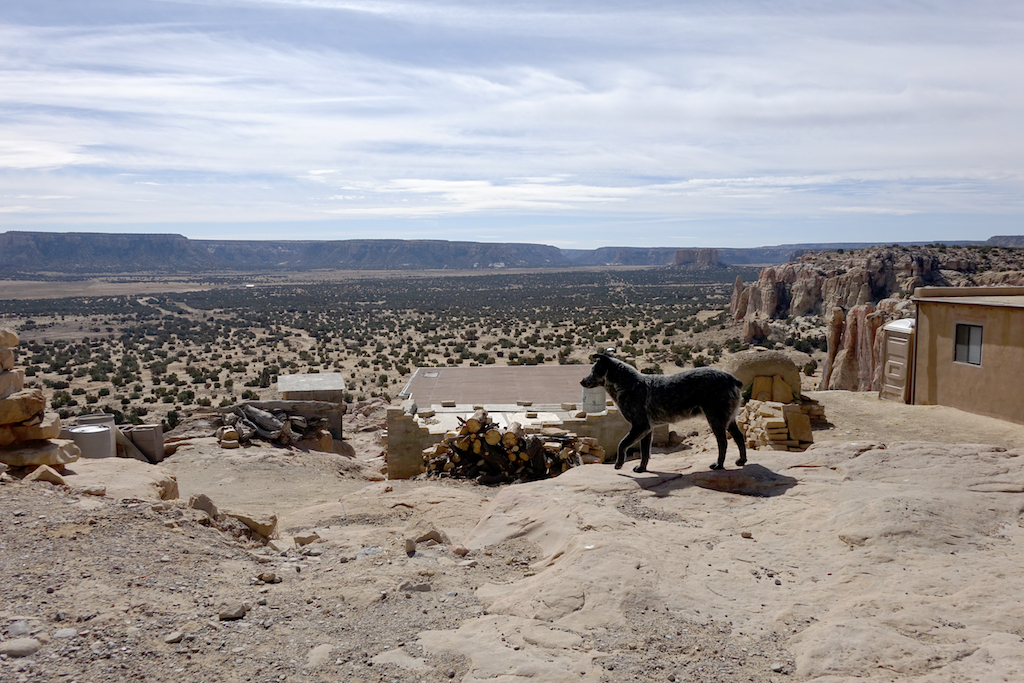
We are now at the end of the tour and are given a choice by Geri to either ride the shuttle van down back to the visitors center or walk. We, along with Kurt, opt to walk, and Irwin says that he'll wrap the pot in bubble wrap, drive down off the mesa and meet us in the guest parking lot where we can settle up.
About 50 feet from Irvin's table Geri walks us over to some hand cut steps, says goodbye and points to the way down. I lead with one of our now ever-present canine escorts in front of me and the other crowding my heels. The steps are steep but quite navigable. They quickly drop between two large sandstone boulders and as they increase in steepness I'm watching the dog ahead of me gingerly trying to navigate the route. In a couple of minutes the steps lead to a rock ledge and as I look down I see step areas cut into the rock and smoothly slotted handholds on both sides as the descent now feels more like stepping down a ladder against a vertical wall. I have to stop to reorganize for two handed climbing. The camera goes into the fanny pack. A print that Terry had bought gets slipped into her handbag that, once I negotiate this simple and scary part of the route, she can lower to me. The dog ahead of me has somehow made it to the bottom and the dog behind me is yipping in "I can't make it, but want to follow" frustration.
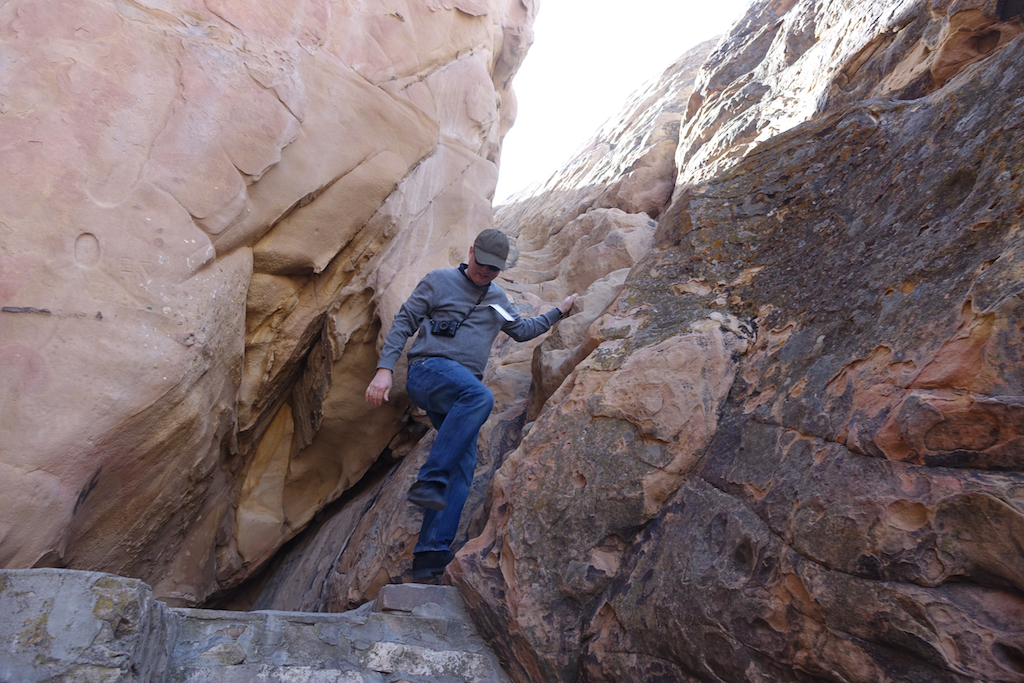
In my younger years of mountain climbing I knew that you had to go against your instinct to face outwards and look down, versus face in and just look at where you place your feet to descend. My fingers fit comfortably in the ancient scooped out handholds as I squeeze tightly with every alternating step downward. It seems longer (it always does), but in a matter of seconds, I'm on a safe and level spot where I can now play spotter for both Terry and Kurt. As the three of us are now comfortably past this completely unexpected experience it gives us all a sense of the ingeniousness and effort the ancient Acoma people possessed to build their very unique pueblo. And as we walk out from the short trail onto the road, our nervous second dog mysteriously appears to excitedly greet us. We were so focused on our descent, we had no idea on how he managed to get down. There must have been a hidden dog passage somewhere or perhaps a bit of ancient spirit magic.
Irvin meets us at the parking lot and the well-wrapped pot and lid are transferred to the back of the Honda. Now it's time to settle up. In making our quick purchase decision at the top of the mesa, Irvin offered that he takes Mastercard and Visa. That sure would be simpler than draining our travel cash or hitting the ATM in the visitors center. Irvin pulls out an iPhone with a little white plastic square attached. He swipes the card across the reader, pecks out the price and then hands Terry a stylus to sign. A few more pecks and Terry's phone dings with the e-mailed receipt. It's just like being in an Apple store except you're in the wilds of tribal territory.
The fascinating moment where ancient art and 21st-century commerce intersect isn't lost on me. Irvin is justifiably proud of his technology. In business parlance, this is called a frictionless transaction and though he may never have heard of the term, Irvin tells me that since he started using his iPhone with the Square card reader that his sales have noticeably increased. No surprise there. For now, unlike many of his fellow artists of the pueblo, he has the ability to instantly turn a whim into a sale. And while this juxtaposition of old and new might serve as a fitting end to my story, we need to return to our walk back to the visitors center with Karl.
Karl's specialty is particle physics. For the last ten years, his interest and field of research have turned to something called: brain-inspired computing. As we walk back to the visitors center on the road Karl gives us an explanation that would be well worthy of a TED talk.
You see, after decades of watching computer power double every few years (Moore's law), there are limitations starting to emerge on the horizon. For instance, when you reduce microprocessors to atomic particle size they become unstable. And yes, while we can make computational technology small, these micro devices require a lot more electrical energy than the human brain does. We may ultimately find ourselves at a technological wall where using the architectures we have known and trusted simply won't work. Advances most likely will come with completely different strategies.
This is where brain-inspired computing comes in. Though I get the sense from Karl that we're long ways away from breakthroughs, this avenue of investigation makes sense as the human brain is the most densely compact and energy efficient device we can model on. Our conversation continues and touches on the biological access of memory and nature of intelligence. As we approach the parking lot business cards are exchanged with the promise to cross e-mail the digital pictures we've taken of our shared morning's experience.
And what a splendid morning this has been! In the sun-drenched high desert mesas of western New Mexico, the macro appreciation comes in visualizing the prehistoric topography. Wetter. Volcanic. And ultimately scoured by wind and water. It's followed by human migration. Perhaps over a Bering Strait land bridge. Perhaps across the Atlantic to South America and then north. Tribes coalesce. Some remain nomadic. Others find a combination of geography and natural elements that form permanent homes. Horses arrive underneath the spurs and leather of Conquistadors. Cultures are changed and, along with them, governments. The speed of news is measured in years, then months, and then nanoseconds.
On a day devoted to looking back at the past, it is surprising to also see ahead into the future. And however that future plays out and brushes against this quiet place of contentment, I'm sure there will be one timeless constant. .a grandmother. .filled with stories, skills, traditions and love that makes the Acoma pueblo so special.
Comments
Comments on this post are moderated, so they will not appear instantly. All relevant questions and helpful notes are welcome! If you have a service inquiry or question related to your RV, please reach out to the customer care team directly using the phone numbers or contact form on this page .